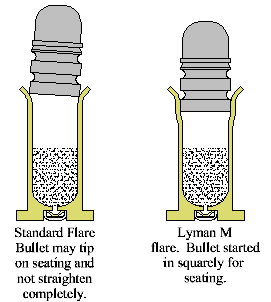Having some problems with what others on the forum have referred to as a "wasp waist" bulge after seating bullets .
The bulge is just barely noticeable and appears at the lowest end of the bullet inside the case, its usually more apparent on one side and appears PRIOR to crimping. While I'm stil a newbie, have loaded several thousand rounds of .357M on the same gear setup without a problem.
Lately I switched to loading 38SP using new Mag brass and with Hornaday "Cowboy Lead" .38 HBWC (148gr). The bullets drop into the the case flare nicely and the seating process is smooth with no problems. Last week I switched to Acme Coated BNWC-NRG (.38 148gr) and the bulging problem started, tried flaring the case mouth more, but it doesnt seem to help. I am seating the BNWC to the same depth as the HBWC's except for allowing the 'button' to protrude from the case. I also tried weighing the BNWC's, and there was deviation of as much as 3gr (148 -151gr); the Hornadays were almost all spot on within +/- .2gr.
I decided to shoot a batch of each (Hornady & Acme) from a rest (GP100 4") to see if the 'bulge' and/or the coated bullets affected accuracy. At 10yds with six rounds was able to punch a .75" grouping with the HBWC, immediately switched to the BNWC's and the next six rounds opened up to a 3" grouping with roughly the same circular pattern as the Hornady.
So cometh my questions:
1. Why are the coated bullet seating process so difficult? and why is the case bulging? Could the WC button cause the bullet to wobble during seating?
2. Could the wasp waist bulge or the improper seating cause the breakdown in accuracy? of perhaps the BNWC or the coating is an issue?
---Has anyone handloaded the Acme Coated BNWC and experienced any problems with seating and/or accuracy?
The bulge is just barely noticeable and appears at the lowest end of the bullet inside the case, its usually more apparent on one side and appears PRIOR to crimping. While I'm stil a newbie, have loaded several thousand rounds of .357M on the same gear setup without a problem.
Lately I switched to loading 38SP using new Mag brass and with Hornaday "Cowboy Lead" .38 HBWC (148gr). The bullets drop into the the case flare nicely and the seating process is smooth with no problems. Last week I switched to Acme Coated BNWC-NRG (.38 148gr) and the bulging problem started, tried flaring the case mouth more, but it doesnt seem to help. I am seating the BNWC to the same depth as the HBWC's except for allowing the 'button' to protrude from the case. I also tried weighing the BNWC's, and there was deviation of as much as 3gr (148 -151gr); the Hornadays were almost all spot on within +/- .2gr.
I decided to shoot a batch of each (Hornady & Acme) from a rest (GP100 4") to see if the 'bulge' and/or the coated bullets affected accuracy. At 10yds with six rounds was able to punch a .75" grouping with the HBWC, immediately switched to the BNWC's and the next six rounds opened up to a 3" grouping with roughly the same circular pattern as the Hornady.
So cometh my questions:
1. Why are the coated bullet seating process so difficult? and why is the case bulging? Could the WC button cause the bullet to wobble during seating?
2. Could the wasp waist bulge or the improper seating cause the breakdown in accuracy? of perhaps the BNWC or the coating is an issue?
---Has anyone handloaded the Acme Coated BNWC and experienced any problems with seating and/or accuracy?


